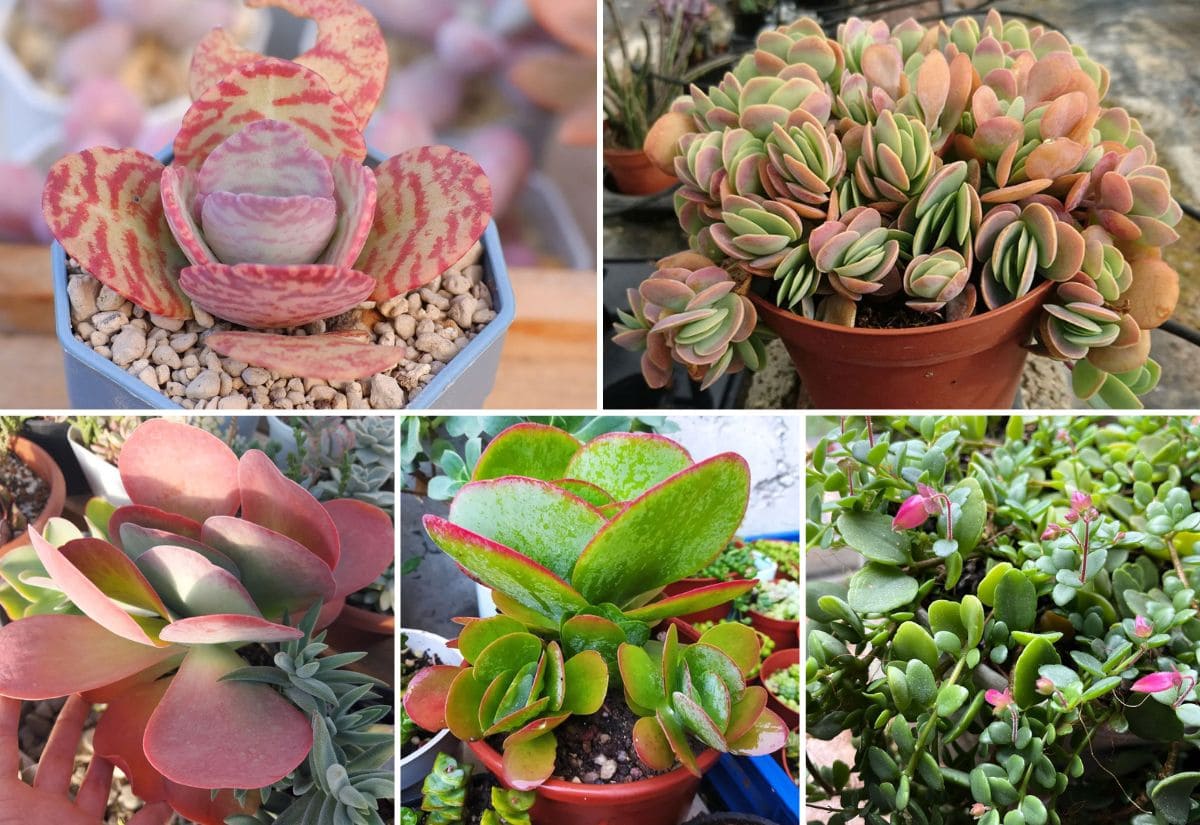
Kalanchoe, the unparalleled shapeshifter in the succulent world, captivates succulent collectors and enthusiasts with its impressive range of features that vary across species. Synonymous with diversity, this genus showcases striking differences in foliage, flowers, habits, cold resistance, and size.
The many varieties, species and cultivars of this genus take on such different shapes, beyond exotic, to quirky and even alien looking – some look like animals, others like jewels…
Kalanchoe is a large genus of succulent plants in the stonecrop family Crassulaceae, native to Madagascar, consisting of about 125 known varieties and numerous cultivars and hybrids of shrubby or climbing perennial tropical plants. Kalanchoe displays a unique ability to produce unusual looking plants and cover a wide range of looks, shapes, and shades. While most species offer abundant and long-lasting flowering, others are distinguished by their highly decorative foliage.
Their fleshy leaves showcase a multitude of amazing colors, while the bright and showy blooms come in dazzling hues ranging from yellow to red.
From the big and potentially invasive Mother of Thousands to the small but cheerful Flaming Katy, and even the striking Kalanchoe Tomentosa with its fuzzy leaves, there’s a Kalanchoe variety to suit every taste and style.
But these captivating plants are more than just a pretty face – they also excel as strong, vigorous, and low-maintenance succulents. With their impressive drought tolerance and rapid growth in many cases, Kalanchoe is a top choice for enthusiasts who appreciate resilience and beauty in equal measure.
It’s no wonder you can find so many types of Kalanchoe both indoors and in gardens, where they grace spaces with their exotic and creative beauty.
In fact, Kalanchoe is such a varied genus that it’s even hard to say what the different varieties have in common.
But the best way to identify your favorites is by looking at some of the most impressive species and cultivars, and, trust me, it is also great fun.
To help you navigate the vast array of Kalanchoe varieties, I’ve compiled a comprehensive list featuring 25 different types of Kalanchoe in detail, with descriptions and photos of each plant. I’ll also provide tips on how to care for your Kalanchoe plants, including watering and light requirements.
With so many varieties to choose from, you’re sure to find a few that you’ll love.
So, get ready for a journey into surreal looking succulents…
But first of all, let’s try to see what unites these very different Kalanchoe varieties, what they have in common.
Kalanchoe: A Shapeshifting Succulent
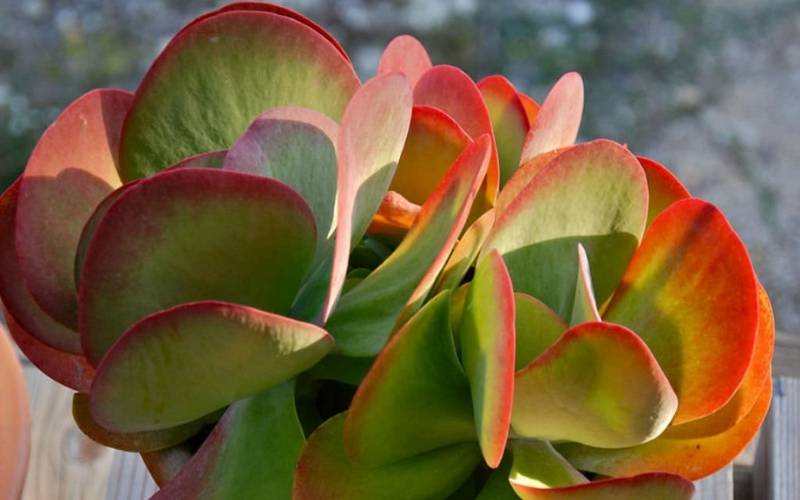
It is hard to pinpoint common traits in kalanchoe varieties. In fact, this genus has an impressive gene pool which allows it to express so many shapes, colors and personalities! It is basically a shapeshifter! But we can try.
We can safely say that they are succulents, most are shrubs or shrubby, most are perennials, but some are biennial and some even annuals. Most originate from Africa, especially Madagascar, but some come from Asia and one species from the Americas!
If there is a common trait to Kalanchoe is that it is varied, wide spread, even puzzling. But let’s try anyway…
Kalanchoe Flowers
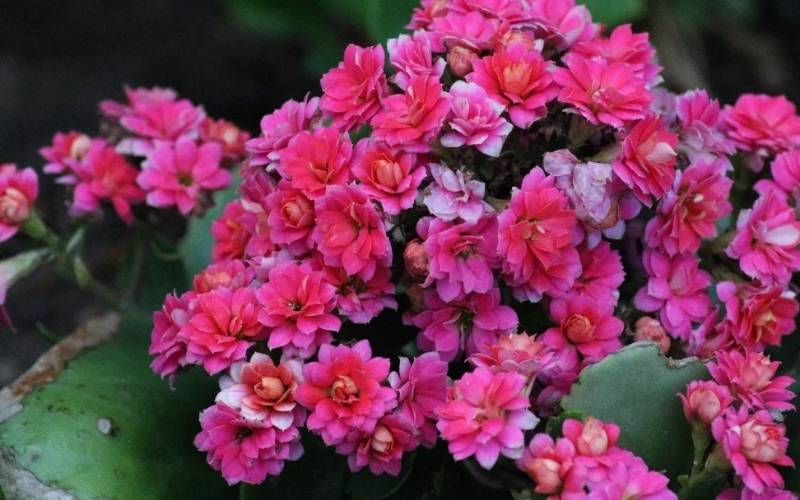
The most steady trait of kalanchoe varieties is the flowers. They are usually tubular, in many colors, the petals are joined, and they are divided in 4 sections and they have 8 stamens.
They open their blooms by producing new cells on the inner parts of the petals, which are pushed outwards by this growth.
Having said this, some varieties like the very popular Kalanchoe blossfledliana, or flaming Katy, have flat looking blooms.
However, I understand that it is hard for a non botanist to work on these small, often invisible traits, so, let’s look at the foliage.
Kalanchoe Leaves
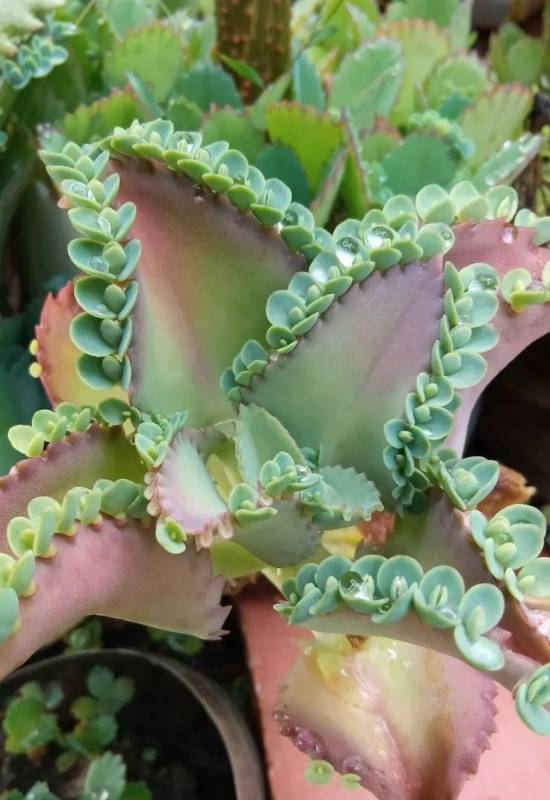
The leaves of kalanchoe can have a lot of shapes, but they are usually fairly broad. But even here, we find the exception, Kalanchoe tubiform from Madagascar has foliage that looks like straws, those we use to drink, and in many colors.
In fact, a characteristic of kalanchoe is the ability to have a wide range of shades and hues in its leaves and branches. These also change with the climate conditions, and you can really have any color in the rainbow!
Some produce pups at on the tips and margins of their leaves, and these are usually grouped into the common generic name of “mother of millions” or “mother of thousands”.
We can only say that kalanchoe is a crazy plant, that does not like monotony at all, and it always comes up with surprising and very different varieties… But if this makes it hard to say what a kalanchoe looks like it also has great decorative potential.
Kalanchoe as a Decorative Plant
With so many shapes and colors, some even alien looking, it is no surprise many kalanchoe varieties have become popular houseplants and garden plants!
From small, sweet looking shrubby succulents like flaming Katy (Kalanchoe blossfeldiana), to the teddy bear like panda panda paws (Kalanchoe tomentosa) and paddle plant (Kalanchoe thyrsi flora), many have found their ways in offices and living rooms.
But kalanchoe is also an excellent outdoor plant; some varieties like devil’s backbone (Kalanchoe daigremontianin) can even become invasive, but watching this fast growing shrub change color all through the year is a real spectacle!
What is more, all kalanchoe varieties are very strong! They will manage even long periods of drought and neglect; they will survive if you break them; they can propagate easily and fast…
If it is hard to “define” kalanchoe, it is easy to appreciate it…
An Important Growing Tip for Kalanchoe
Kalanchoe is a low maintenance, strong and vigorous succulent, but be careful with water. It is very drought tolerant but on the contrary wet soil can cause root rot and even its death. Only water it when the soil is fully dry, and with little water.
If you underwater it, it will survive, and you can always add some more; if you overwater it, you run the serious risk of losing it.
A second, bonus tip: some Kalanchoe varieties don’t like strong light, unlike other succulents… It can cause leaf burn; on the other hand, this makes these amazing plants suitable for shady gardens!
But now, some key facts about this amazing genus…
Kalanchoe Care Factsheet
Even if Kalanchoe is such a varied genus of succulents, here are some key facts that give you an easy to use guide.
25 Colorful Kalanchoe Varieties To Make your Garden Pop
The best way to know kalanchoe is to see as many varieties as you can, then you will identify even little known species once you get used to this shapeshifting succulent. We could “only” select 25 varieties out of all the amazing impersonations of Kalanchoe, but we made sure we picked the most beautiful and decorative ones, and here they are! So, let’s start with a household name…
1. Flaming Katy (Kalanchoe Blossfeldiana)
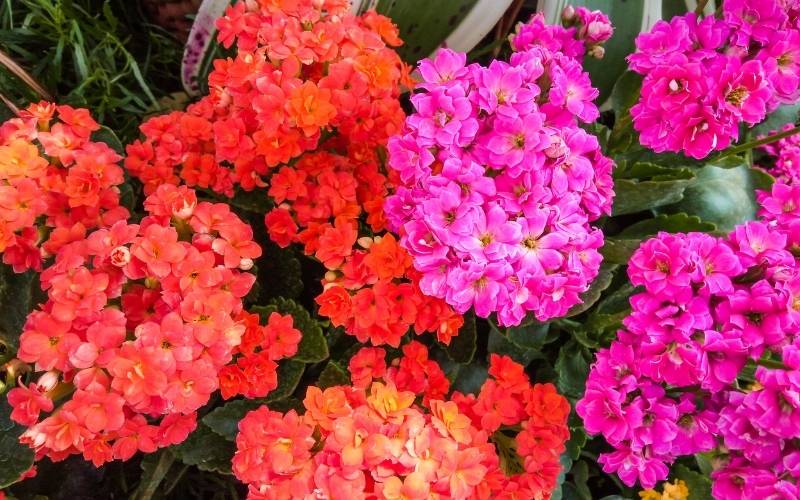
Flaming Katy is a very popular kalanchoe variety, grown both indoors and outdoors. With broad, glossy and bright green leaves that form a dense clump at the base, Kalanchoe blossfeldiana displays its blooms in clusters, or umbels, just above the foliage.
The flower heads can be single or double, small but vigorous and long lasting: up to 6 months in fact, even if each head will last “only” 6 weeks. These are also brightly colored in white, yellow, pink, orange or red.
Very easy to grow and small, it has also won the famous Award of Garden Merit by the Royal Horticultural Society.
Grown in containers indoors, flaming Katy is a cheerful little succulent to brighten up all sorts of environments. But don’t forget its value as an outdoor plant in flower beds, rock gardens or, again, in pots.
2. ‘Oracular’ (Kalanchoe luciae ‘Oracular’)
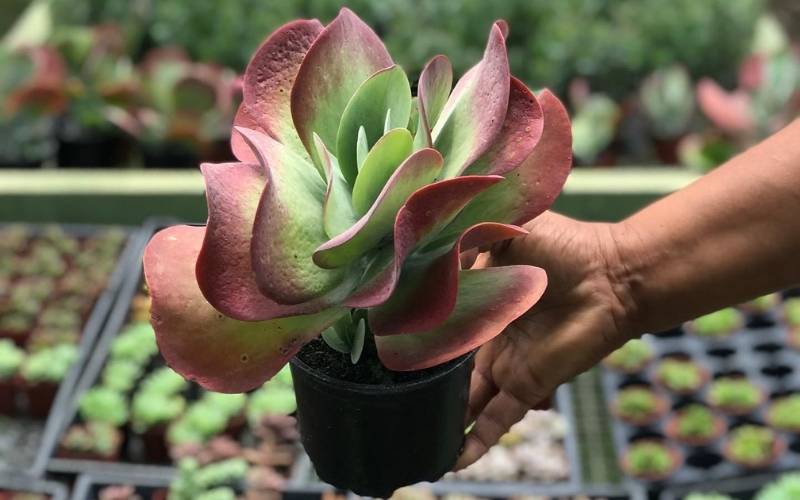
‘Oracular’ is an original looking cultivar of Kalanchoe Lucia also called lady fingers. But its name comes from ears, with a reference to ear lobes… The succulent leaves, in fact, form a paddle or spoon n like shape, in clumps or actually “unruly rosettes” that look like they are listening to you.
The coloring changes throughout the season; it takes on hues of gray, bluish green, orange, pink or even red! It looks a bit like a creature from the depth of the ocean, but it will bloom as well.
The flowers are small, inconspicuous, yellow, and smaller than the stems that bear them though.
But it is mainly for its incredible foliage that you will want ‘Oracular’ at home, or even in your garden especially if you have a rockery and you want a succulent with a very unusual touch.
3. Flapjack (Kalanchoe thyrsiflora)
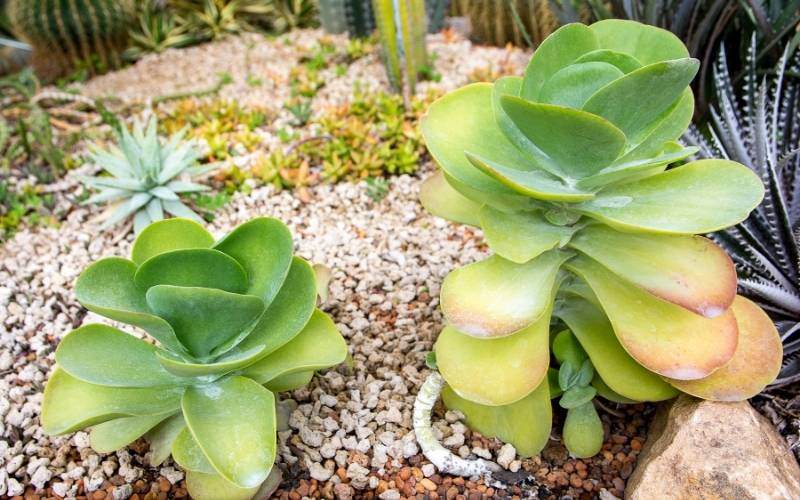
Flapjack, also called paddle plant, is a sweet looking kalanchoe variety that children love, for its soft and welcoming shapes.
In fact, the rounded, succulent leaves form lovely rosettes that grow on short stems. In a way, they look like desert roses, the sculptural crystals, which is yet another name for this species.
The “paddles” have a smooth surface, but with a “floury” icing on them. They can be green, blue, and they often take on pink and red blushes as well, especially late in the season. The flowers come on long gray stems, and they are yellow but very small indeed.
Flapjack is both very decorative and heart warming; indoors, you can keep it like a living statue that changes color; outdoors it is ideal for desert, gravel and rock gardens.
4. Blooming Boxes (Kalanchoe Proliferate)
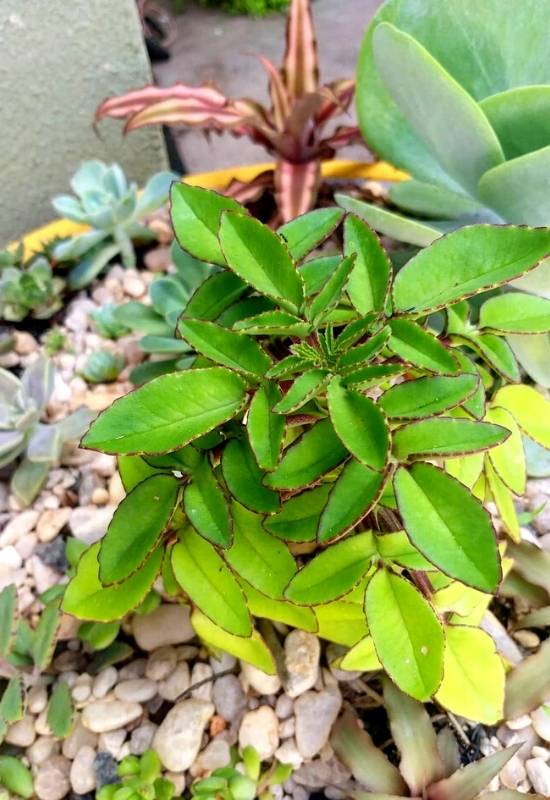
Even if blooming boxes is not yet a very popular kalanchoe variety, I am sure it will soon become one! The sculptural value of this succulent is in fact outstanding.
Unlike other species, it looks like a small tree with regular opposing branches that arch downwards from the top of a long stem, like a dome, or the ceiling of a well designed gothic cathedral, forming an umbrella with the dense and lush foliage! The leaves are elliptical and crenelate, usually bright green with purple margins, but yellows and reds are possible too! The flowers are bright red, tubular and nodding, coming out of green sepals that look like capsules with 4 sides, or boxes…
Blooming boxes is a real wonder, super sculptural in all its aspects, it can be a worthy centerpiece in any room or a specimen plant in a garden. It really takes center stage.
5. Panda Plant (Kalanchoe tomentosa)
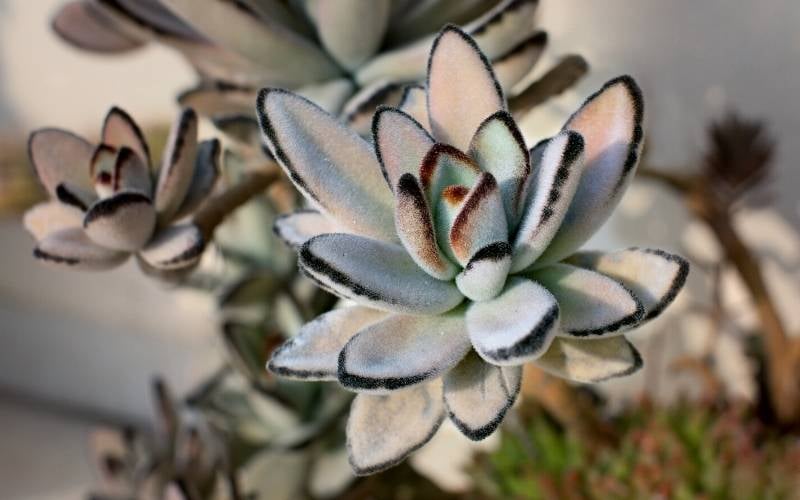
Another child friendly variety of kalanchoe is surely panda plant! It is so called because the fleshy concave elliptical leaves have a short and light fluff on them, and they also have an interesting coloring… they are gray blue, but with many maroon dots at the edges, that look like short nails, or the paws of the rarest bear in the world.
Forming lovely soft clumps, they also produce fluffy blooms! The tubular flowers are hairy and green or gray with purple tips outside, but purple with a yellow center inside, small but very unusual.
Yet another variety that adapts well to both indoor and outdoor spaces, panda plant will add a soft and cuddly touch to rooms as well as gravel, desert or rock gardens.
6. Coral Bells (Kalanchoe uniflora)
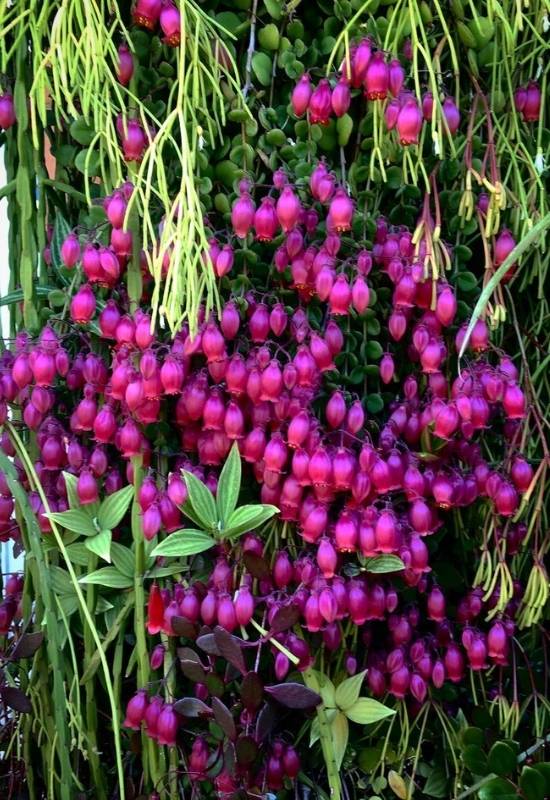
Here is another shape shifting trick from the kalanchoe genus for you: coral bells. To start with, it is a trailing succulent, with long thin stems that drop down and fill with small, rounded green leaves that take on purplish edges with good light.
Starting at the tips you will also enjoy the showy, pink to magenta blooms that come in spring, but they can also spread up to cover the whole plant! The flowers are long, tubular and with a swelling in the middle, almost bell shaped, and a great spectacle indeed.
Coral bells is a hanging basket variety of kalanchoe, both indoors and outdoors. However, if you have a rock garden on a slope, consider planting a specimen or two for a cascade of lovely leaves and energetic flowers!
7. Marnier’s Kalanchoe (Kalanchoe Marnie Riana)
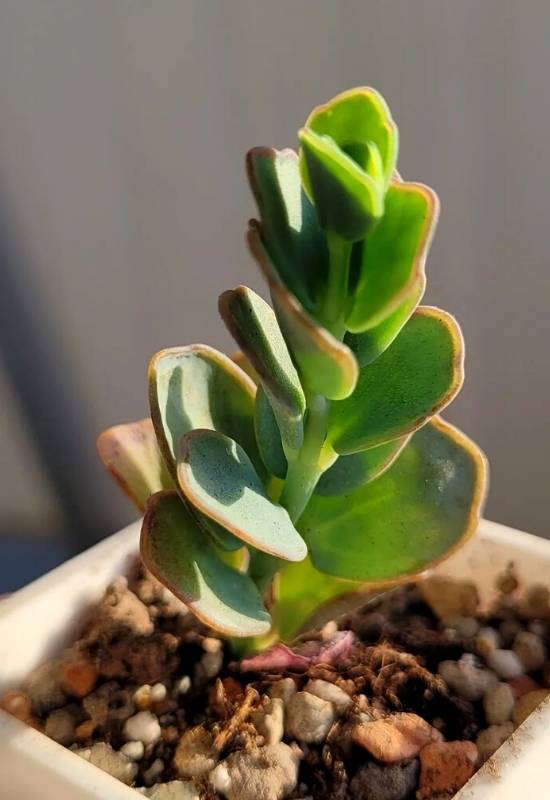
Marnier’s kalanchoe is a small, spreading species from Madagascar. On the thin stems you will find oval to round opposing leaves, regularly spaced and blue green in color, sometimes even pink violet, with pink or purple edges, like coins on a string… At the tips, clusters of bright red blooms nod beautifully above this sea of beautifully textured foliage.
Tubular and waxy in texture, the blooms are a great contrast with the predominant cold colors of the rest of this plant, like little fire lanterns on a calm tropical sea. And they can blossom any time of the year!
Marnier’s kalanchoe is great as ground cover or in rock gardens outdoors. It is less common indoors, but there is no reason why you cannot grow it if you like it.
8. Donkey Ears (Kalanchoe gastonis-bonnieri)
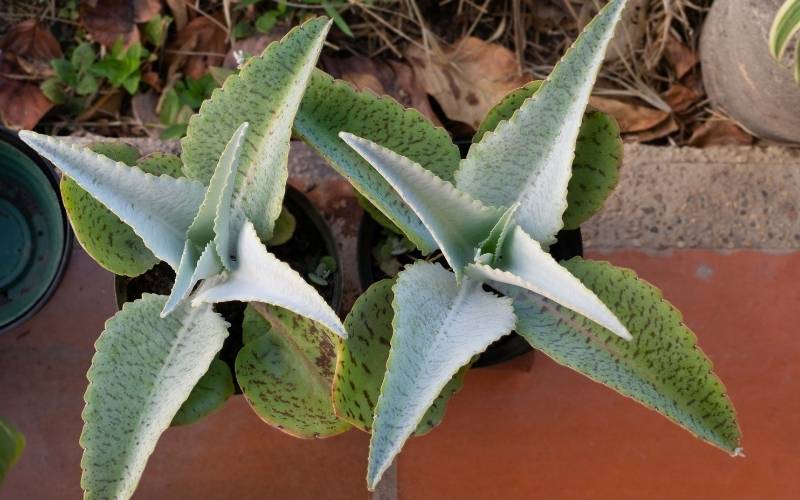
Another shapeshift into an animal lookalike plant that kalanchoe offers us is with donkey ears… Now you see long, pointed and soft looking smooth leaves with serrate edges. With a green to blue color and purple dots regularly scattered all over the surface.
They can reach 20 inches in length (50 cm). Long stems will appear in fall, and they will bear clusters of lovely green and pink buds. Later in the season, they will lengthen and open, revealing bright red petals joined in nodding tubular flower heads.
Donkey ears is a common outdoor kalanchoe variety that suits well more classical designs for succulents, like desert or rock gardens, but also in flower beds and low borders it can really add a lot of value.
9. Kalanchoe Humilis (Kalanchoe humilis)
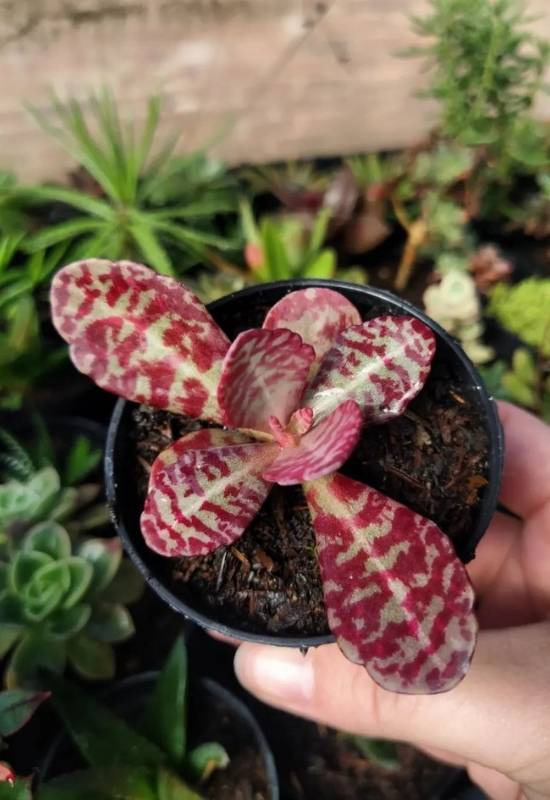
The scientific name of Kalanchoe humilis means “humble”, but wait till you see it… The stems of this variety grow upward, and they have large, paddle shaped succulent leaves that can reach 5 inches long (12.5 cm), and… The twist is that they have tiger like stripes of bright purple and pale blue green! The blooms come like fountains on long pink gray stems, they are small, but the overall effect is really fantastic, also thanks to the delicate interlacing pf glaucous violet, pink and pale blue! The colors may change with light conditions, but this species is a real artist with an amazing palette.
More common as a houseplant, Kalanchoe humilis can also grace a rock garden in fairly warm climates; just make the best of its color in combining them with those of the stones. In fact, it’s one of the hardiest varieties of this genus.
10. Pies from Heaven (Kalanchoe Rhomb Pilosa)
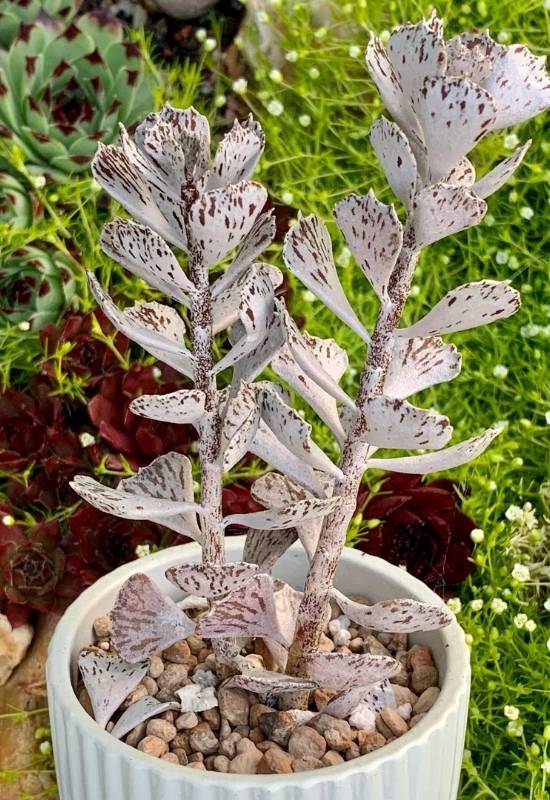
Pies from heaven looks like an elegant work of art. The leaves are fan shaped, with waved edges, and they open outwards in beautiful rosettes that look like Baroque saucers from above.
The whole is heightened by the almost white, or very pale gray, with brown dashes that decorate them like the best ceramic work! The flowers are small, coming on long stems and they are waxy with a star shaped mouth, of a very pale green to yellowish shade.
The color pattern of this amazing variety for. Madagascar makes it one of the most decorative houseplants ever, and it too can grow outdoors, just imagine it in a gravel or rock garden where you play with its zebra like “skin”…
11. Mealy Kalanchoe (Kalanchoe Scaliger)
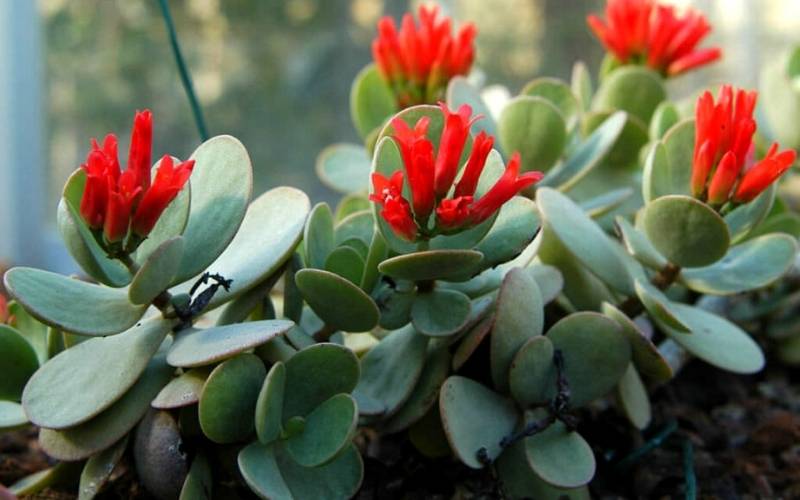
Mealy kalanchoe is a very neat looking variety of this amazing genus. The broad, round leaves are almost disk shaped, forming very balanced rosettes.
They are blue to green, pale in color, with pink edges and a very thin layer of white powder, or icing on them. This refreshing backdrop is then sparked up when it blooms.
The bright scarlet red flowers will come up from their middle, displaying the full energy of these sparkling tubular flowers that look upwards in clusters that look like a little fire!
Small and suitable for even modest spaces, like coffee tables and book shelves, mealy kalanchoe will also give you a burst of color and sculptural foliage in flower beds or rock gardens outdoors in warm climates.
12. Pretend Flowered Kalanchoe (Kalanchoe Manganic‘Tessa’)
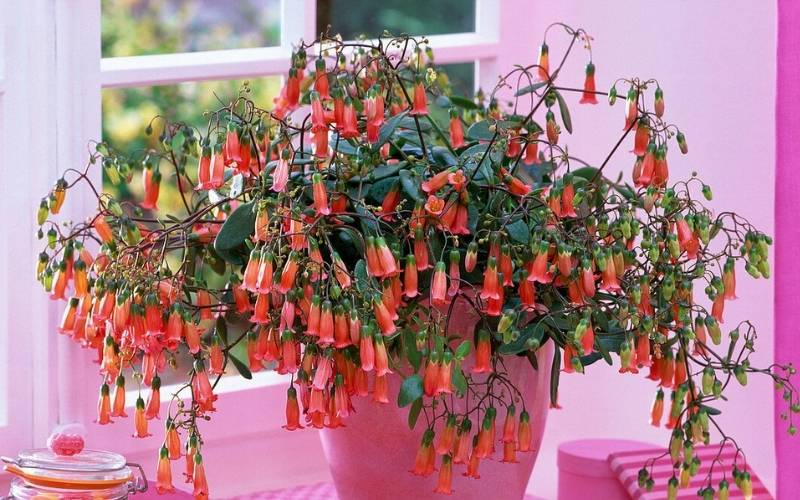
For an elegant variety with lovely blooms, look at pretend flowered kalanchoe… The stems are very thin, almost invisible if they were not purplish red in color. And they hold small, round leaves in shades of green and purple, especially at the edges.
But this cultivar is mainly loved for its super glossy, fiery red tubular and nodding flowers! These come in large clusters atop stems of a darker shade of red, like an explosion, but in winter, when most other plants are dormant. And they stay on for a long time!
Small but spectacular, elegant but showy, pretend flowered kalanchoe is a slender looking but vibrant variety that will look great in informal settings indoors, and in garden beds or other places where you’d expect succulents, like desert, rock and gravel gardens.
13. Common Kalanchoe (Kalanchoe rotundifolia)
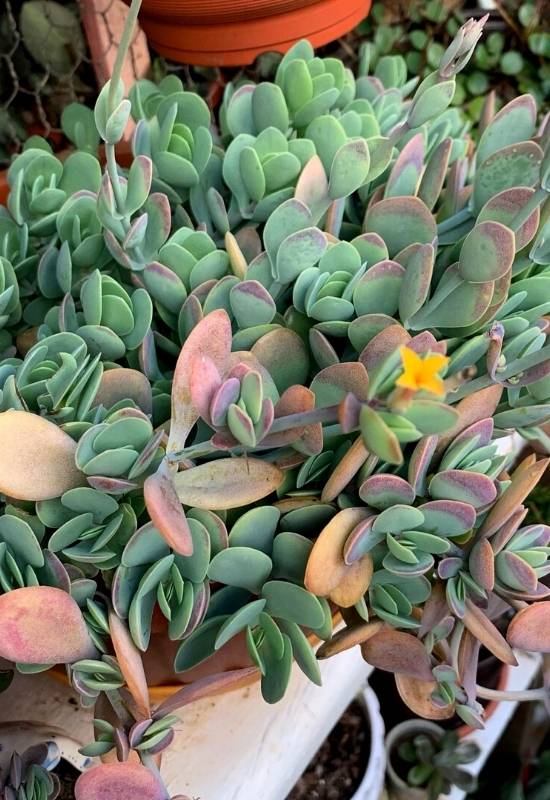
Common kalanchoe may be a misleading name for this lovely variety. The leaves are tightly packed on the stems and they look like thin jade stones, round with a thin edge! The trailing branches hold them beautifully together like clams or like a precious necklace, but these gems can change change lots of colors, from pale green to bluish, pink, orange, red or even some purple blushes! This master of disguise will betray itself, and you will be sure you are not looking at a jewel when clusters of bright red to yellow tubular flowers with a star shaped mouth appear above it once a year!
For shape and color, common kalanchoe looks great near rocks outdoors and indoors, maybe add a few, or some feature to the container to highlights its unusual “stone like” appearance.
14. Alligator Plant (Kalanchoe Daigremontianin)
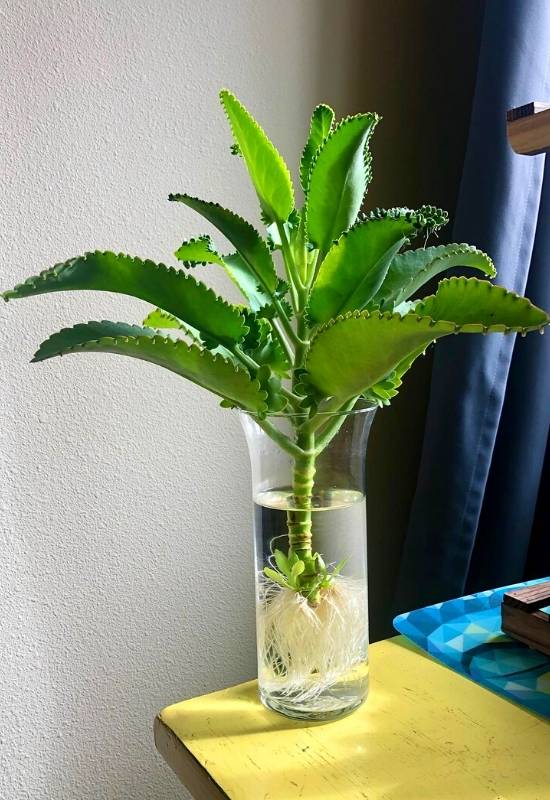
Like Zeus, Kalanchoe can take on the appearance of animals, and alligator plant is a clear example! This fast growing shrubby succulent is one of the many “mother of thousands” varieties, with leaves that look like crocodile heads, and many little offsets, or pups, on the margins.
The foliage is variegated and it has many spots, and it can vary in shade, with green, gray, pink, red, purple and bluish on its palette. The blooms are flaming red, in clusters and tubular, very attractive indeed as they nod from the tall stems.
Alligator plant is a garden variety, but be very careful, it is really invasive! The pups fall from the leaves and they produce new plants everywhere, and each specimen can have an impressive number of them.
15. Kalanchoe x Richardia (Kalanchoe x Richardia)
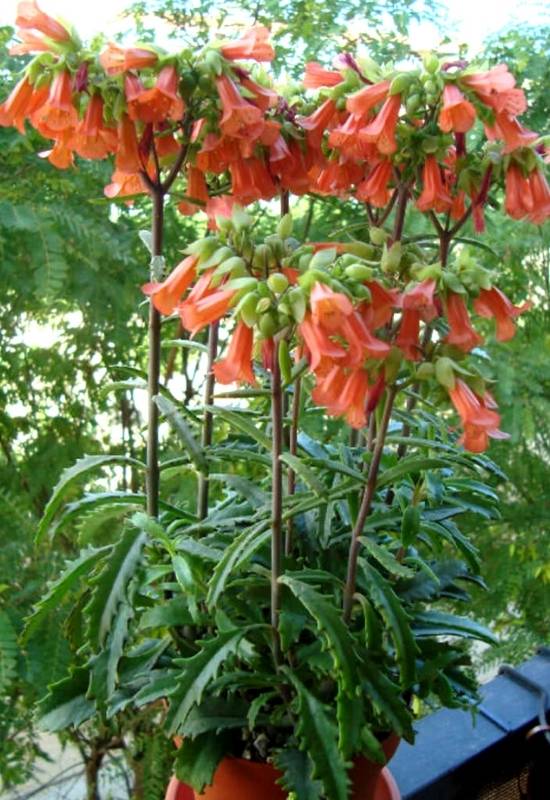
Kalanchoe x richardia is a slender looking variety of this morphing genus… It has long, erect and thin stems, usually on the pale purple range, with drooping leaves that hang downwards, quite slender and teethed, or serrated, almost rectangular in appearance.
The foliage has shades of bright green, yellow, orange, copper and pink. When they are small, they form beautiful rosettes where pink is the predominant color.
The long lasting, nodding, tubular blooms come in clusters when this succulent grows tall, and they are quite showy with yellow, orange and red shades in them, contrasting with the pale green sepals at the top.
A good houseplant when young, Kalanchoe x ritualic is better outdoors when it grows; it is very elegant and it could work quite well in borders, thanks to its shrubby look.
16. Millet Kalanchoe (Kalanchoe Maloti subsp. Maloti)
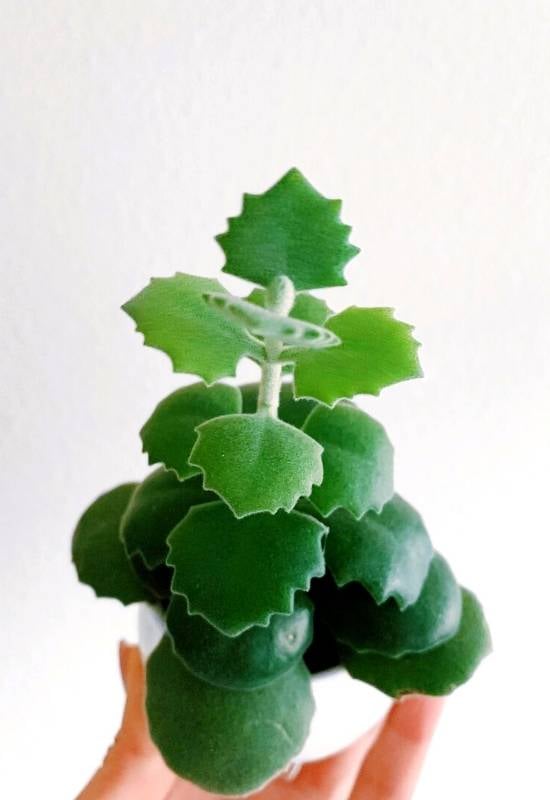
A small variety, Millot kalanchoe forms short shrubs with dense and soft looking foliage. The leaves are serrated and they look like little cat paws, actually green but thanks to the dense and short white fuzz that covers them, they appear blue from a distance.
However, they can take on pink and yellow blushes, or even change color, when they age. Blooming in summer, the flowers are long and almost completely covered by the sepals, but you can still see the white to pink petals popping out at the very end.
Lovely in small containers if you want to grow Millet kalanchoe indoors, it will look beautiful as a small and colorful shrub in rock gardens or flower beds outdoors.
17. Six-Angled Kalanchoe (Kalanchoe Sexangular)
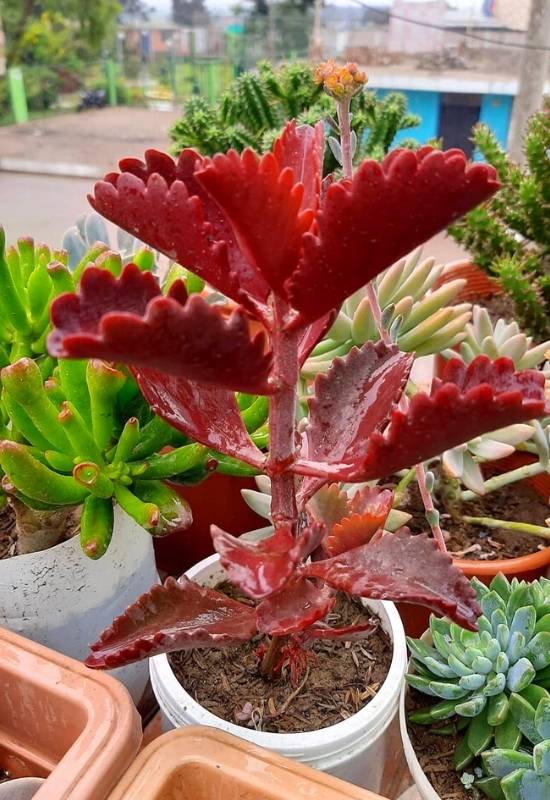
The foliage of this shrubby succulent, six-angled kalanchoe, is really decorative and interesting. Coming on short, ridged stems, the leaves are actually elliptical in shape, but because they are cupped upwards, and scalloped, they give you a very striking texture.
As usual, the color has a good palette, with greens and ruby purples, especially along the margins, but you can also find bluish and orange blushes.
The blooms offer a great contrast, coming far above the plant with large clusters of small, yellow flowers. And they will last for 6 weeks or even 2 months!
Six-angled kalanchoe is great for low beds, edging and of course rock gardens. It is mainly an outdoor variety, but you can have it indoors as well.
18. Lavender Scallops (Kalanchoe Leshchenko)
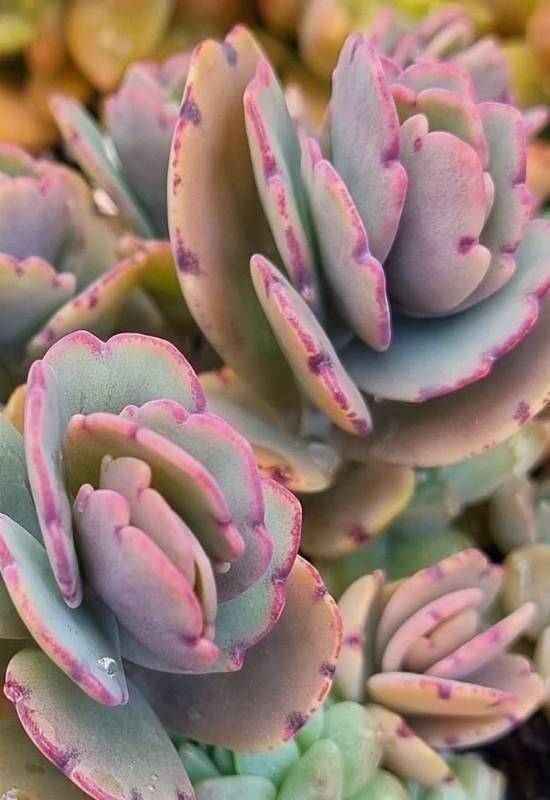
Lavender scallops is a Kalanchoe variety with many, many attractive traits. The leaves are round, like shells, packed together on thin stems, and they have a lovely blue color with pink edges, which are scalloped.
They form a 3D display like you would expect to see on rocks und the sea. Sometimes, they take on other colors as well, like pale orange and rose.
Conversely, the clusters of flowers come well above them on thin stems, and they are nodding, bell shaped and pink to red in color.
Maybe the best asset of this succulent is really the contrast between such delicate, different but balanced hues.
It is self evident that lavender scallops is ideal in rock gardens or flower beds, also as ground cover, but it is also a worthy and enchanting houseplant variety!
19. Snow White Panda Plant (Kalanchoe Epiphylla)
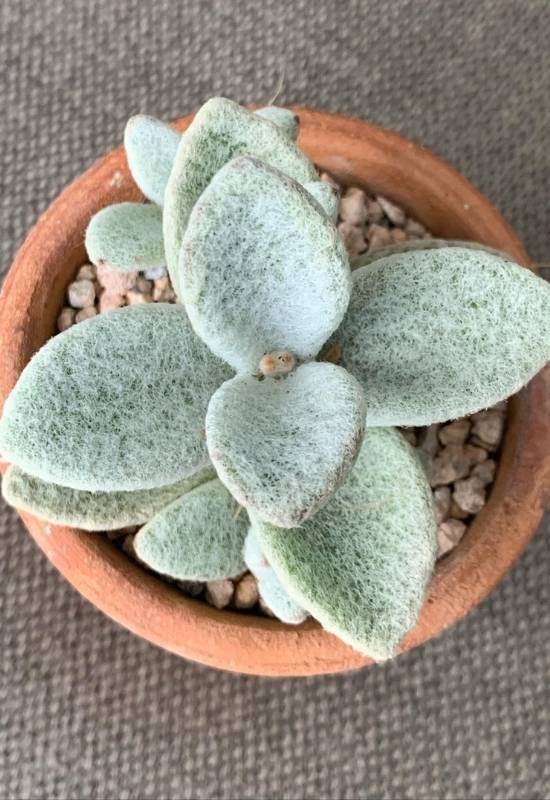
Shifting back into sweet looking shapes, the genus Kalanchoe offers us a really tender beauty, snow white panda plant.
The rosettes of oval, very succulent small leaves, curved upwards and covered in a dense white fuzz look like candies with sugar one them… And they appear blue to silver, sometimes with pink blushes.
Just above them small white to rose flowers with four petals complete the delicate smile of thus child friendly variety.
Small and cuddly, snow white panda plant is ideal for indoor spaces, even shelves and coffee tables; however, if you have an outdoor garden with low flower beds, or a rock garden, in a warm region, don’t forget to plant a few specimens to soften them with its charm.
20. Mother of Thousands (Kalanchoe x Lactivores)
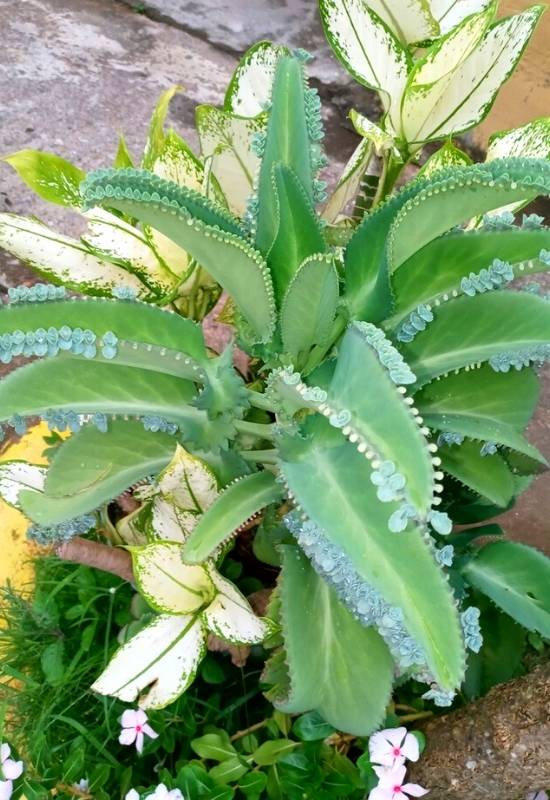
A few Kalanchoe varieties are called mother of thousands, or mother of millions, but this hybrid is the most typical of all.
The scientific name means “lushly green” and in fact the long and broad leaves, up to 8 inches (20 cm), are bright green with delicate veins, but… The serrated edges fill with pups, lovely rosettes that usually take on a vivid bluish color instead.
But the whole foliage can turn pink with magenta offsets in the right light! The long, nodding tubular but almost bell shaped flowers in flat topped clusters pick up this theme, with magenta, pink and sometimes yellowish shades.
Grown both indoors and outdoors, this lush variety of mother of thousands is a real spectacle in borders and beds, but be careful… Every pup means a new plant, and it can become very invasive indeed.
21. Variegated Paddle Plant (Kalanchoe Lucia ‘Fantastic’)
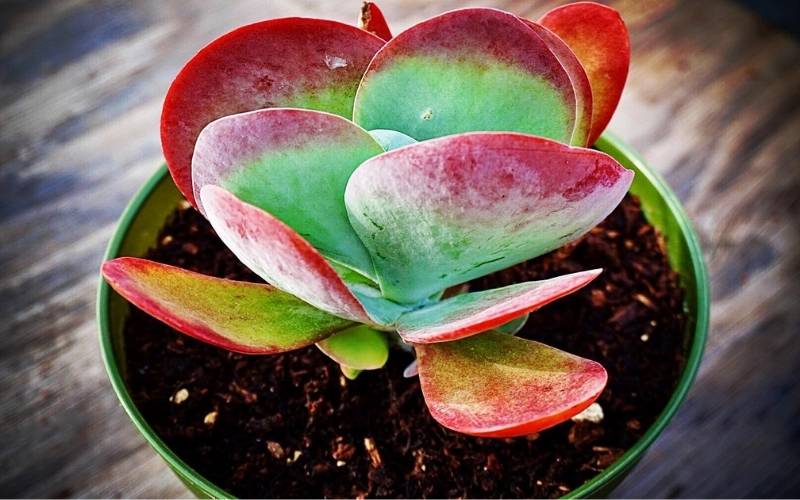
With so many different species of Kalanchoe, we have not found much space for cultivars, but ‘Fantastic’ variegated paddle plant really deserves a spot! The broad, smooth, clam shaped succulent leaves you find in rosettes are a real explosion of colors! You will find broad and elegant patches of green, pink, cream yellow, blue and purple and even bright red on them! And they are big, up to 6 inches long (15 cm) and 5 inches wide (12.5 cm).
Just impressive! On the other hand, the flowers are pale yellow, tubular and they come on long stems far above the foliage…
Mainly an indoor variety, ‘Fantastic’ variegated paddle plant will change its color with time and light conditions. But if you have a low bed or rock garden that needs an injection of vibrant colors and you live in the right climate zone… Go ahead!
22. Felt Bush (Kalanchoe Behrens’s)
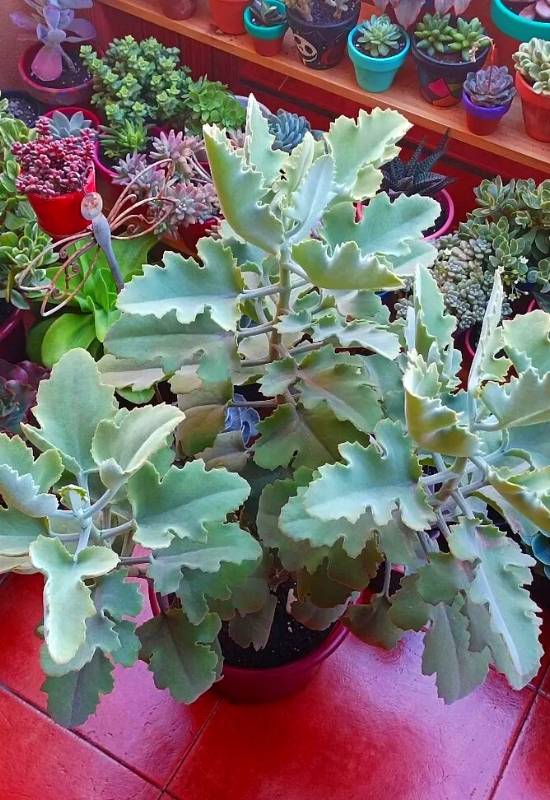
Here is another weird looking variety of Kalanchoe, called felt bush. It grows into what looks like a small tree, with an upright stem and then branches, and these bear rosettes of huge, hastate leaves 5 to 14 inches long (12.5 to 35 cm) and 3 to 12 inches wide (7.5 to 30 cm). They arch and they have deeply cut and spiked margins.
They look a bit like the succulent version of a thistle… The color can range from gray, to green, blue and sometimes pink or purple patches appear. On the contrary, the flowers are small and greenish, not very showy.
Felt bush is a very big variety of Kalanchoe, you can have it indoors while it is young, but then you will need to find it a permanent place either in a border, or as a specimen plant in your garden.
23. Pen wiper Plant (Kalanchoe marmorata)
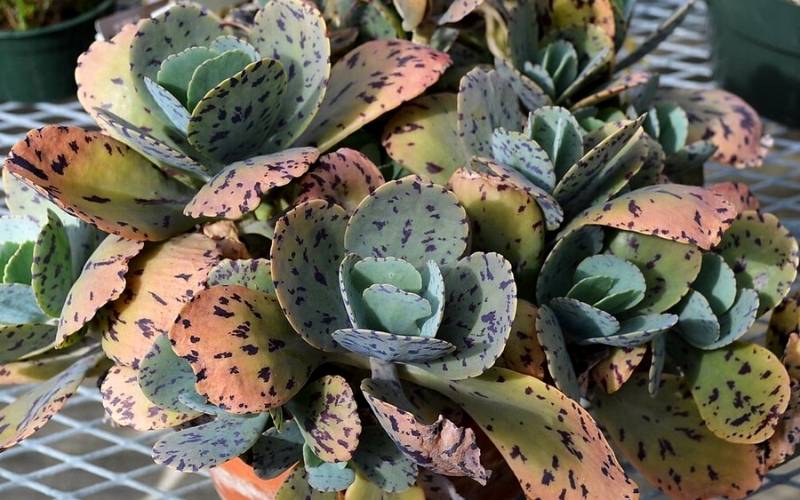
Shapeshifting into a desk object, Kalanchoe gives us pen wiper plant… Lovely rosettes with scalloped succulent leaves are the shape of this variety, but then we need to look at the colors.
A backdrop of pale blue and green at the base and pastel lilac pink towards the edges is interrupted by a marbled effect with strong purple patches, that look like ink stains! Now you understand the funny name… The flowers are beautiful as well: very thin and very long tubular and white, they open at the tips with a star of four snow white petals. These look up from the tips of this elegant plant.
Yet another variety you can grow indoors, pen wiper plant is also a great asset in flower beds, borders and rockeries.
24. Copper Spoons (Kalanchoe Royalism)
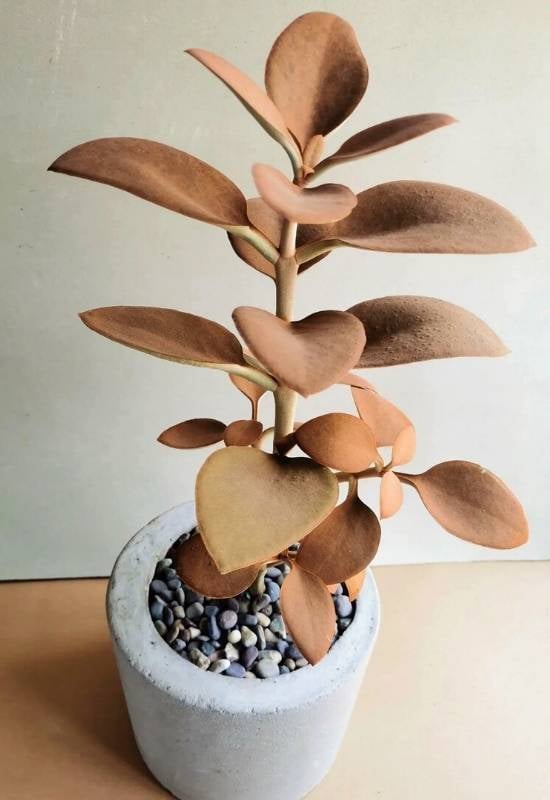
Get ready for another amazing change in the Kalanchoe genus: copper spoons! With long and thin upright stems, this succulent displays open arrangements of elliptic leaves with thin points, in opposite pairs.
They have a fine velvet texture, to which they add amazing colors. A very clear copper is what gives this variety its name, but brown, blue, green, silver or white are also possible, even on the same plant.
It looks like a bronze sculpture, but when the bell shaped, waxy and golden clusters of upward looking flowers appear, you realize it is actually an exotic plant.
Obviously, copper spoons is a very decorative houseplant, almost an object d’art; but if you are lucky and you live in a warm country, its contribution to flower beds and gravel and rock gardens can be superb!
25. Chandelier Plant (Kalanchoe Diagenesis or Kalanchoe Tubiform)
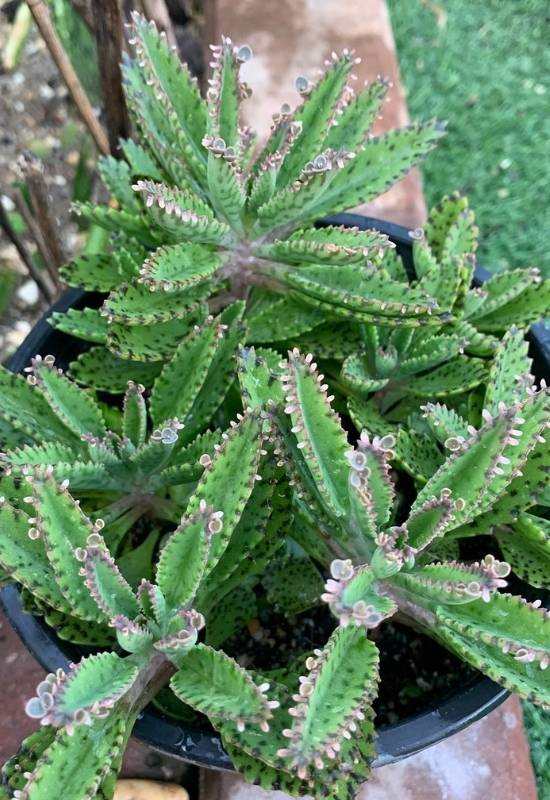
The last transformation of Kalanchoe we want to show you comes from another mother of thousands (or millions) variety: chandelier plant.
It grows fast and upright, with long and narrow leaves that look like straight sticks, or from above, the spokes of a bicycle wheel… Variegated with leopard spots, they have a palette with green, gray, blue, silver, pink and purple! The edges are flanked by many little rosettes, the offsets, or pups, which, falling, grow into new plants.
The trumpet shaped flowers dangle in dense showy clusters from the top of the stems, with their bright orange or scarlet color!
Chandelier plant is mainly an outdoor variety of Kalanchoe, where it can look exotic and even “alien” in borders or beds, but you can also have it indoors. Be careful with the pups… It is a very invasive species. And don’t forget that the whole plant is toxic…
Kalanchoe: The Shapeshifting Champion Of Succulents
Succulents are famous for their varied and unusual shapes, as well as for their vast palette of changing colors, but now you have seen just a selection of Kalanchoe varieties, I think you’ll agree with me in giving her the winning prize for the biggest shapeshifting genus of all!

Written By
Emily O Bethke
Born in northern Wisconsin, Emily has always had a passion for plants. This passion has led her to work in greenhouses, landscaping, and academic plant research at multiple university’s. She graduated from the University of Wisconsin Milwaukee with a BS in conservation and environmental science. When she isn’t caring for her plants or writing you can find her traveling, cooking, at live music shows, and spending time in nature.

Thank you very much.
Good information.